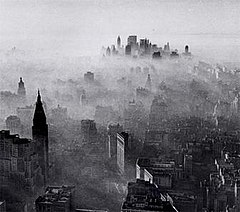
Back ১৯৬৬ নিউ ইয়র্ক শহরের ধোঁয়াশা Bengali/Bangla Smog de New York en 1966 French Smog de Nova York em 1966 Portuguese 1966年纽约烟雾事件 Chinese
 On November 25, 1966, the front page of The New York Times featured this photograph by Neal Boenzi. Taken the morning before, the photo shows a view facing south from the Empire State Building.[1] Roy Popkin of the EPA said the "surrealistic" image made Lower Manhattan look like a science-fiction "Cloud City".[2] | |
| Date | November 23–26, 1966 |
|---|---|
| Location | Acute smog in New York City; lesser smog throughout the New York metropolitan area |
| Coordinates | 40°42′47″N 74°00′22″W / 40.713°N 74.006°W |
| Cause | Heat inversion over East Coast[3] |
| Casualties | |
| 168 (estimate from 1967 medical study)[4] | |
The 1966 New York City smog was a major air-pollution episode and environmental disaster, coinciding with that year's Thanksgiving holiday weekend. Smog covered the city and its surrounding area from November 23 to 26, filling the city's air with damaging levels of several toxic pollutants. It was the third major smog in New York City, following events of similar scale in 1953 and 1963.
On November 23, a large mass of stagnant air over the East Coast trapped pollutants in the city's air. For three days, New York City was engulfed in dangerously high levels of carbon monoxide, sulfur dioxide, smoke, and haze. Pockets of air pollution pervaded the greater New York metropolitan area, including parts of New Jersey and Connecticut. By November 25, the smog became severe enough that regional leaders announced a "first-stage alert". During the alert, leaders of local and state governments asked residents and industry to take voluntary steps to minimize emissions. Health officials advised people with respiratory or heart conditions to remain indoors. The city shut off garbage incinerators, requiring massive hauling of garbage to landfills. A cold front dispersed the smog on November 26, and the alert ended.
In the months that followed, medical researchers studied the smog's impact on health. City officials initially maintained that the smog had not caused any deaths, but it soon became clear that the smog had significantly harmed public health. A study published in December 1966 estimated that 10% of the city's population had suffered adverse health effects, such as stinging eyes, coughing, and respiratory distress. A statistical analysis published in October 1967 found that 168 deaths had likely been caused by the smog.
The smog catalyzed greater national awareness of air pollution as a serious health problem and a political issue. The government of New York City updated local laws on air-pollution control. Prompted by the smog, President Lyndon B. Johnson and members of Congress worked to pass federal legislation regulating air pollution in the United States, culminating in the 1967 Air Quality Act and the 1970 Clean Air Act. The extent of harms from subsequent pollution events, including the health effects of pollution from the September 11 attacks and incidents of pollution in China, have been judged by reference to the 1966 smog in New York.
- ^ The New York Times 1966a.
- ^ Popkin 1986, p. 28.
- ^ Popkin 1986, p. 27.
- ^ Bird 1967d.
© MMXXIII Rich X Search. We shall prevail. All rights reserved. Rich X Search